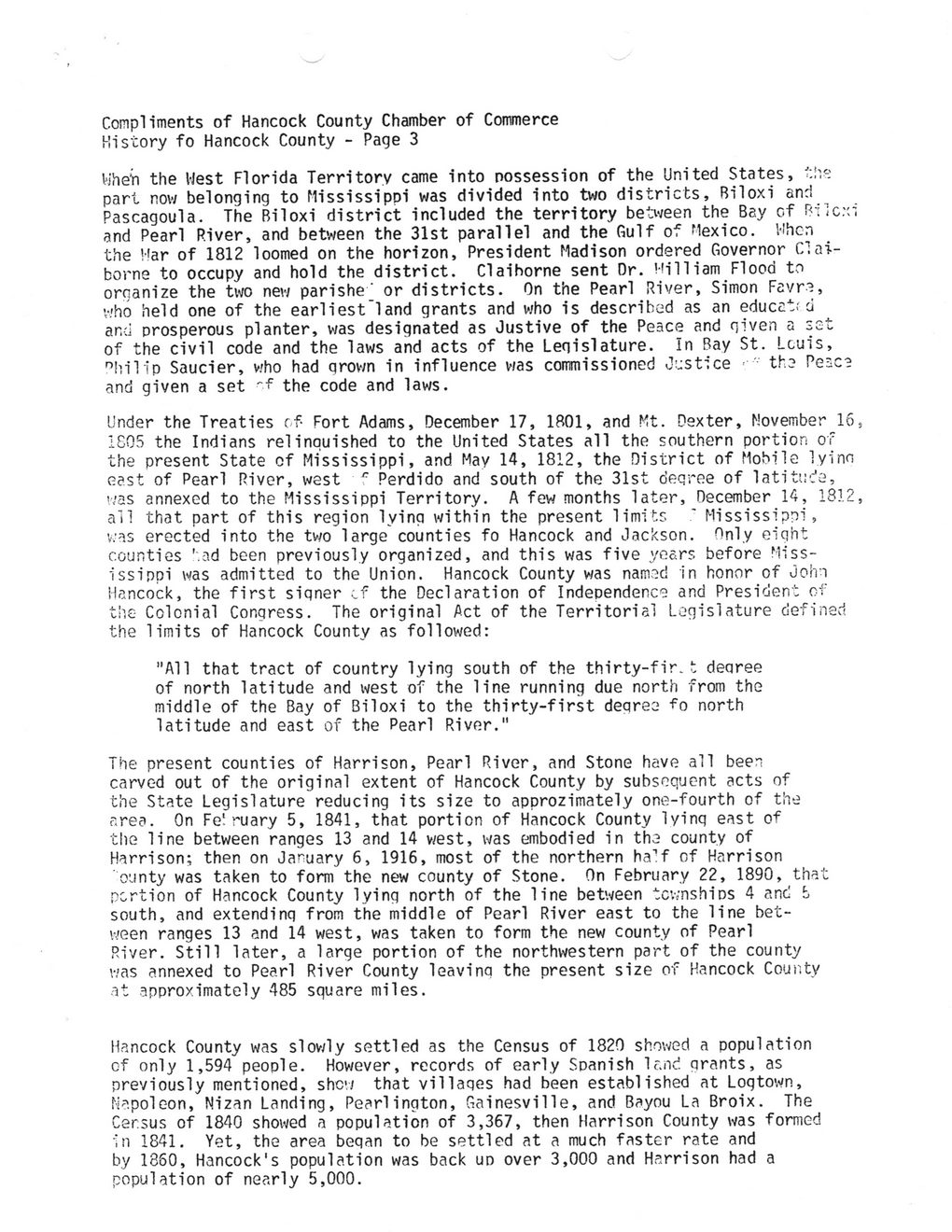This text was obtained via automated optical character recognition.
It has not been edited and may therefore contain several errors.
Compliments of Hancock County Chamber of Commerce History fo Hancock County - Page 3 Whe'n the West Florida Territory came into possession of the United States, t'.'.z part now belonging to Mississippi was divided into two districts, Biloxi and Pascagoula. The Biloxi district included the territory between the Bay of Bilcxi and Pearl River, and between the 31st parallel and the Gulf of Mexico. Whc-n the War of 1812 loomed on the horizon, President Madison ordered Governor Claiborne to occupy and hold the district. Claihorne sent Dr. William Flood to organize the two new parishe ' or districts. On the Pearl River, Simon Favrs, who held one of the earliest’land grants and who is described as an educet;. d and prosperous planter, was designated as Justive of the Peace and qiven s set of the civil code and the laws and acts of the Legislature. In Bay St. Lcuis, nhilip Saucier, who had grown in influence was commissioned Justice ' the Pesce and given a set -f the code and laws. Under the Treaties of- Fort Adams, December 17, 1801, and Mt. Dexter, November 16, 1805 the Indians relinquished to the United States all the southern portion of the present State of Mississippi, and May 14, 1812, the District of Mobile l.yinn east of Pearl River, west r Perdido and south of the 31st degree of latitude, was annexed to the Mississippi Territory. A few months later, December 14, 1812, all that part of this region lying within the present limits ' Mississippi, vms erected into the two large counties fo Hancock and Jackson. Only eiqht counties ’.ad been previously organized, and this was five years before Mississippi was admitted to the Union. Hancock County was named in honor of John Hancock, the first siqner the Declaration of Independence and President of the Colonial Congress. The original Act of the Territorial Legislature defined the limits of Hancock County as followed: "All that tract of country lying south of the thirty-fir. t degree of north latitude and west of the line running due north from the middle of the Bay of Biloxi to the thirty-first degree fo north latitude and east of the Pearl River." The present counties of Harrison, Pearl River, and Stone have all been carved out of the original extent of Hancock County by subsequent acts of the State Legislature reducing its size to approzimately one-fourth of the area. On February 5, 1841, that portion of Hancock County lyinq east of the line between ranges 13 and 14 west, was embodied in the county of Harrison; then on January 6, 1916, most of the northern half of Harrison ounty was taken to form the new county of Stone. On February 22, 1890, that portion of Hancock County lying north of the line between townships 4 and b south, and extendinq from the middle of Pearl River east to the line between ranges 13 and 14 west, was taken to form the new county of Pearl River. Still later, a large portion of the northwestern part of the county was annexed to Pearl River County leaving the present size of Hancock County at approximately 485 square miles. Hancock County was slowly settled as the Census of 1820 showed a population of only 1,594 people. However, records of early Spanish Ic.nd grants, as previously mentioned, shew that villaqes had been established at Loqtown, Napoleon, Nizan Landing, Pearlington, Gainesville, and Bayou La Broix. The Census of 1840 showed a population of 3,367, then Harrison County was formed in 1841. Yet, the area began to be settled at a much faster rate and by 1860, Hancock's population was back up over 3,000 and Harrison had a population of nearly 5,000.

Hancock County History General History-of-Hancock-County-(03)